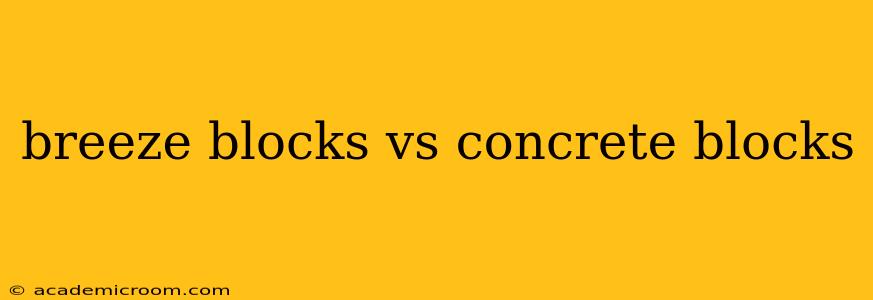Choosing the right building block can significantly impact the aesthetics, functionality, and overall cost of your project. This comprehensive guide dives deep into the differences between breeze blocks and concrete blocks, helping you make an informed decision. We'll cover everything from their properties and uses to their environmental impact and cost-effectiveness.
What are Breeze Blocks?
Breeze blocks, also known as aircrete blocks or porous concrete blocks, are lightweight building blocks made from a mixture of cement, sand, and other aggregates, but with a significant portion of the mix consisting of air pockets. These air pockets are what give breeze blocks their characteristic porous texture, allowing for better airflow and natural ventilation.
Advantages of Breeze Blocks:
- Enhanced Ventilation: The porous nature of breeze blocks promotes natural airflow, keeping interiors cooler in warmer climates. This can lead to reduced reliance on air conditioning, saving energy and money.
- Lightweight: Their lightweight nature makes them easier to handle and transport, potentially reducing labor costs.
- Aesthetic Appeal: The unique texture and pattern of breeze blocks add a distinct aesthetic quality, making them popular in both traditional and modern designs.
- Improved Acoustics: The air pockets within the blocks can help to absorb sound, offering better acoustic insulation than solid concrete blocks.
Disadvantages of Breeze Blocks:
- Lower Strength: Compared to concrete blocks, breeze blocks are generally less structurally strong. They are suitable for partition walls and less load-bearing applications.
- Water Absorption: The porous nature that enhances ventilation also makes them more susceptible to water absorption, which can lead to dampness and potential structural issues if not properly treated.
- Limited Load-Bearing Capacity: Due to their lower strength, they are not suitable for load-bearing walls in most building projects.
- Maintenance: Regular maintenance and appropriate sealing may be needed to prevent water damage.
What are Concrete Blocks?
Concrete blocks, also called cinder blocks or CMU (Concrete Masonry Units), are solid or hollow blocks made from a mixture of cement, aggregates (like sand, gravel, or crushed stone), and water. They are denser and stronger than breeze blocks.
Advantages of Concrete Blocks:
- High Strength: Concrete blocks offer superior structural strength compared to breeze blocks, making them suitable for load-bearing walls and foundations.
- Durability: They are highly durable and resistant to wear and tear, resulting in a longer lifespan.
- Fire Resistance: Concrete blocks offer excellent fire resistance, adding to the overall safety of a building.
- Cost-Effective: Concrete blocks are often a more cost-effective option, especially for larger construction projects.
Disadvantages of Concrete Blocks:
- Poor Insulation: Concrete blocks are typically poor insulators, leading to higher energy consumption for heating and cooling.
- Heavyweight: Their weight makes them more challenging to handle and transport, potentially increasing labor costs.
- Less Aesthetic Appeal: Concrete blocks generally have a less visually appealing appearance compared to breeze blocks. While finishes can improve aesthetics, it is still a consideration.
- Less Ventilation: The solid nature of concrete blocks provides little to no natural ventilation.
Breeze Blocks vs. Concrete Blocks: A Head-to-Head Comparison
| Feature | Breeze Blocks | Concrete Blocks |
|---|---|---|
| Strength | Lower | Higher |
| Weight | Lightweight | Heavyweight |
| Ventilation | Excellent | Poor |
| Insulation | Moderate (depending on the block) | Poor |
| Cost | Can be slightly more expensive | Generally less expensive |
| Load-Bearing | Usually not suitable for load-bearing | Suitable for load-bearing |
| Appearance | Unique and aesthetically pleasing | More utilitarian appearance |
| Water Absorption | Higher | Lower |
What are the best blocks for a particular project?
The best choice between breeze blocks and concrete blocks depends entirely on the specific needs of your project. Consider these factors:
- Structural requirements: For load-bearing walls or foundations, concrete blocks are the better choice. For partition walls or non-load-bearing structures, breeze blocks might be suitable.
- Climate: In hot climates, breeze blocks can help keep interiors naturally cool, reducing energy costs. In colder climates, the poor insulation of both options might necessitate additional insulation.
- Aesthetics: If aesthetic appeal is a priority, breeze blocks' unique texture might be preferred.
- Budget: Concrete blocks are generally cheaper, but the long-term energy savings from using breeze blocks in appropriate climates might offset the initial cost difference.
Are breeze blocks environmentally friendly?
Breeze blocks can be considered more environmentally friendly in certain aspects, particularly their contribution to passive cooling, potentially reducing the energy consumption of air conditioning. However, their higher water absorption may require more careful handling and potentially more maintenance. The environmental impact of both breeze blocks and concrete blocks depends on the materials used and manufacturing processes.
Which block type is better for soundproofing?
While neither option is a perfect soundproofing solution, breeze blocks generally offer slightly better sound absorption due to their porous nature. However, for truly effective soundproofing, additional measures like specialized soundproofing materials would be needed regardless of the block type.
By carefully weighing these factors, you can select the building block that best suits your project requirements, ensuring both functionality and aesthetics. Remember to consult with a qualified builder or architect for professional advice tailored to your specific circumstances.
